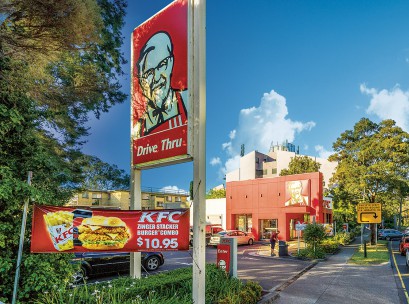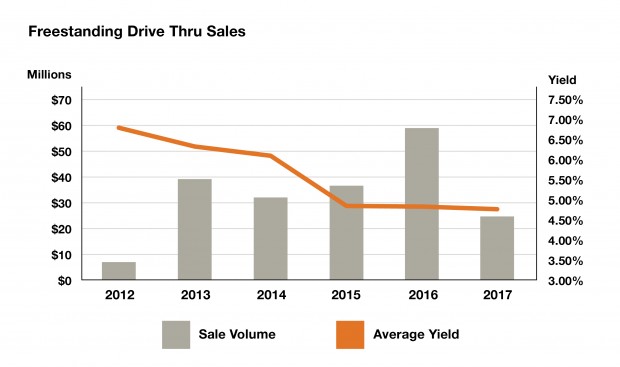 Investor demand for fast food assets continues to far outstrip supply and drive a market upswing, according to property firm Burgess Rawson’s latest investment report on the sector.
Investor demand for fast food assets continues to far outstrip supply and drive a market upswing, according to property firm Burgess Rawson’s latest investment report on the sector.
The report highlights fast food sales yields have compressed from a median 6.95 per cent in 2012 to 4.92 per cent in 2017/18, across metropolitan and regional locations. These investments generally range in price from under $1 million to $6 million with incomes starting from approximately $35,000 p.a. for a regional shop front.
“These highly-sought after assets have a low risk profile with an upside and continue to grow in popularity, particularly with investors who own self-managed super funds,” said Simon Staddon, director at Burgess Rawson.
“They offer long-term indexed income streams, underpinned by strong land values.
“Demand continues to increase for these tightly held set and forget assets, with many landlords holding multiple properties. Investors are prepared to pay a premium to de-risk their property portfolios.”
Burgess Rawson, has sold over 78 per cent of major drive through freestanding fast food assets Australia-wide over the past five years with sales totalling over $310 million.
“These assets are an excellent investment to include in a balanced property portfolio,” said Neil Honan, managing director of Honan Partners Chartered Accountants.
“Three of the biggest global brands – McDonalds, KFC and Hungry Jacks continue to invest heavily in expansion plans, they have strong lease covenants and the structure of leases is often 10 years with the option to extend by 10 years to offer tenure security.
“In addition, food is a defensive asset class that is recession proof – people always need to buy food, long operating hours offers excellent value from a rental perspective and new fit-outs which cost in some cases hundreds of thousands of dollars, enable strong depreciation.”
Digital demand heats up
Investor interest in the fast food sector is being driven by the sector’s ability to embrace digital technology; Australia’s appetite for fast food; relative affordability, identifiable global brands; and prominent locations with secure long-term tenants, according to Staddon.
“The fast food sector’s capacity to embrace digital technology has helped accelerate growth,” he said.
“Early adopters who harnessed the potential of Uber Eats have witnessed a significant increase in sales and customer reach. As the commercial investment market continues to grow, investors are often placing more importance on the asset class as opposed to geographical location.
“The yield differential for fast food assets in metropolitan and regional areas has narrowed. There is now a minimal yield difference between the two,” who pointed to the recent sale of a Guzman Y Gomez in regional Coffs Harbour in NSW as demonstrative of the yield differential.
“It sold on a low 4.50 per cent yield in December 2017, which is considered a metropolitan yield [the lower the yield the higher the price].
“Whilst location was an important driver for the purchaser from Perth, the asset class and tenancy profile were the primary motivators.”
 Growth in the fast food services industry in Australia has been strong over the past five years (2013 – 2018) with revenue rising by 3.7 per cent annually to $20 billion. There are just over 24 million Australians who eat out on average two to three times a week, which is more than 50 million meals each week, or 2.5 billion in a year, according to Source: Eat Out in Australia 2017 Respondent Summary.
Growth in the fast food services industry in Australia has been strong over the past five years (2013 – 2018) with revenue rising by 3.7 per cent annually to $20 billion. There are just over 24 million Australians who eat out on average two to three times a week, which is more than 50 million meals each week, or 2.5 billion in a year, according to Source: Eat Out in Australia 2017 Respondent Summary.
“Emerging players to watch in the fast food space include Oliver’s, Zambero, Guzman y Gomez and Taco Bell,” said Ingrid Filmer, director at Burgess Rawson.
“Core global players including Hungry Jacks, KFC, McDonalds and Red Rooster continue to invest heavily with robust expansion plans.
“Australians enjoy eating out and this trend set to continue. The expanding list of fast food choices including healthy options will grow to cater for the masses. We are also noticing a move towards ‘going green’. The younger generation – Gen Y in particular is driving an interest in giving back to local communities and environmental initiatives.”
“Sustainability programs by franchisees and vendors in the areas where they operate is helping engender community spirit and expand customer bases,” added Filmer.
Access exclusive analysis, locked news and reports with Inside Retail Weekly. Subscribe today and get our premium print publication delivered to your door every week.





